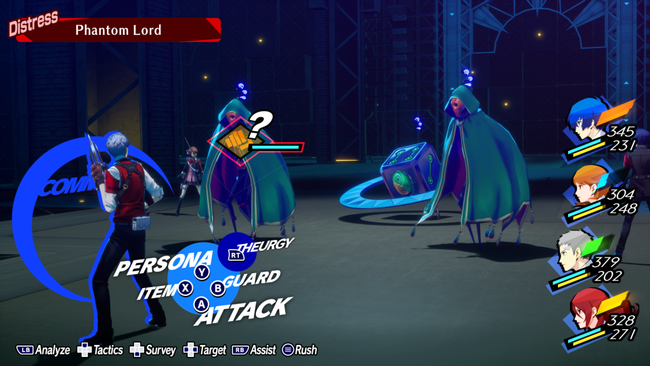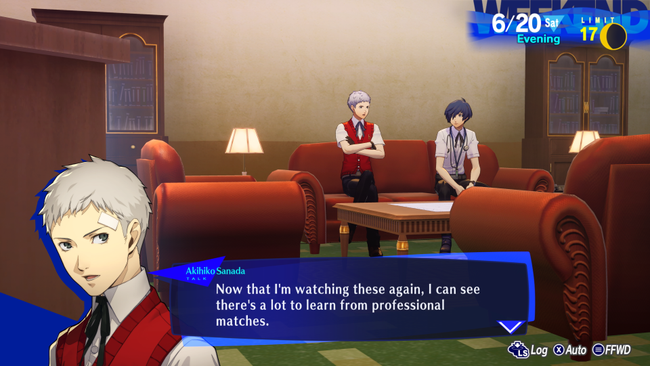
Persona 3 Reload Review
Playing Persona 3 Reload for this review left me feeling deja vu. It was only a year ago, almost to the day, that I first revisited Tatsumi Port Island and got reacquainted with the members of S.E.E.S (Specialized Extracurricular Execution Squad) with last year’s HD release of Persona 3 Portable. While Portable’s new port left me unimpressed, I can happily say that Persona 3 Reload is a fantastic remake of the game that set the course that the Persona franchise still follows today.
As is the case in every iteration of Persona 3, you play as a transfer student who finds himself joining the secret S.E.E.S group that handles the mysterious Shadows that terrorize Tatsumi Port Island during the Dark Hour. This hidden hour at midnight transforms the nearby school into the towering labyrinth known as Tartarus, which holds the secrets to the Dark Hour and the persistent Shadow threat. You and the rest of the S.E.E.S team will deal with the progressively more dire threat posed by the Shadows and the nefarious STREGA group that looks to stop you and bring about the world's end.
.jpg)
Also, as is the case in other versions of Persona 3, you will be splitting your time between saving the world and dealing with the trials and tribulations of being a teenager - going to class, making friends, and fusing the demons that live inside your head. You will have the chance to run around various locations of Tatsumi Port Island, visiting shops, working odd jobs for cash, and improving your relations with fellow students and strangers you meet.
When you aren’t dealing with school quizzes and your friends’ latest crises, you will spend most of your time in Tartarus, grinding up levels, completing requests, and recruiting personas. This atmospheric, procedurally generated dungeon has floor after floor of increasingly more difficult enemies and better rewards, acting as the perfect place to get stronger, with higher levels of the tower locked behind story progression milestones.
When I saw the initial reveal trailer for this full remake of Persona 3, I wondered how true this latest release would be to the previous incarnations. Would it be simply like I was playing Persona 5 with the cast from Persona 3, with the red aesthetic changed to blue, or would it be more like a beautified version of the original Persona 3 that aims to rest on its updated visuals? Persona 3 Reload comfortably sits closer to the latter, with a few modern additions, redone graphics, and some fleshed-out story beats, but the bones of the original game are still front and center.

The most apparent updates to Persona 3 Reload are its brand-new visuals, redone music tracks, and all-new English voice actors. The least surprising takeaway is the striking visuals, with highly detailed characters, personas, and shadows. Taking inspiration from the more modern art direction of Persona 5, all the characters are now of realistic proportion, which you will be seeing much more of in Reload as explorable environments have returned, dropping the visual novel approach to exploration in last year’s Portable remaster.
Persona 3’s classic soundtrack has also received a complete overhaul in Reload, with longtime Persona vocalist Yumi Kawamura — who originally performed many of the classic tracks — being replaced by singer Azumi Takahashi. For the most part, these new arrangements sound good, but some land better than others. Paulownia Mall’s track, for example, is faster and feels more pop-y, whereas the original felt more laid back, like you were hanging out around the mall with friends. Honestly, though, after playing so many versions of the game with the original soundtrack, I couldn’t tell you with one hundred percent certainty if this isn’t just a case of “old man doesn’t appreciate change” or if my feelings that some of the new tonal styles just don’t fit as well are valid. Regardless, I wish all remakes would offer the option to switch between the new and original arrangements, but that’s not the case here.

The new voice actors all do a lovely job, but sometimes I wonder what their direction was when portraying these much-beloved characters. The approaches felt like a strange mix of “this is my take on the character” and “this is my take on the original voice actor’s performance of the character,” with no apparent pattern from one to the next. Akihiko, now expertly voiced by Alejandro Saab, has a more intense and clear character performance, sounding distinctly different from Liam O'Brien's original performance. On the opposite side of the coin, Zeno Robinson, who voices Junpei in Reload, sounds almost identical to the character’s original actor, Vic Mignogna - Zeno still did a fantastic job, I was just confused by it. Between the approaches, I found the more distinct new performances to be better, as they lent themselves more to Reload being a remake rather than those coming off as trying to emulate a previous voice performance.
Atlus has gone to great lengths to increase the number of scenes that are fully voiced in Reload compared to the earlier versions. Now, every Social Link scene is voiced instead of just the first and last link scenes. Well-done voice performances for the game’s numerous NPC characters make these impactful and emotionally poignant moments even more memorable.
Additional scenes have also been added throughout Reload, called Link Events, that act as pseudo-Social Links between the main character and the other male members of S.E.E.S that explore and enrich the stories behind the boys on the team. Fans of the Strega group will also be pleased to hear that Reload will provide you with new information, peeling back the curtains behind their motivations and more. These nuggets of new narrative were welcome surprises to discover as someone who has played through this game several times before.
Both the social and Tartarus sides of Persona 3 Reload’s gameplay have seen some tweaks and additions that weren’t present in previous versions of the title. On the more social side of things, the S.E.E.S dorm now features some new amenities, such as growing vegetables on the roof, cooking with teammates, or kicking back and relaxing watching a movie in the common room, among others. These new activities provide you with more options to improve your social stats, get items, and get to know the cast better.
.jpg)
Exploring Tartarus and grinding essentially the same as it did in previous versions of Persona 3, being repetitive at times, but some adjustments have made grinding for better loot easier, at the expense of some features. Floors of Tarturus, especially earlier on, feel considerably smaller with the more open view that Reload’s updated visuals provide. No longer are you able to split up your party to find the exit or hunt down shadows, though before too long, you do gain the ability to send a party member on to “scout ahead” the floor above. Upon joining back up, they will gift you some items they found - honestly, I’m not that impressed with this new feature and would have preferred if Reload retained the option to let me split up the party.
Skill cards are also far easier to obtain this time around with Sword Cards during Shuffle Time (which has seen its “minigame” removed), rewarding you with them instead of the random weapons you would get in other iterations. There are also new types of rare monsters and a unique NPC in Club Escapade that increases the spawn rate of rare and powerful shadows, further speeding up the grind. The new Monad Passages that can appear on later floors also provide a nice challenge to test your team composition and strategies, rewarding you with items, outfits, and other goodies.
In combat, Persona 3 Reload has adapted several mechanics inspired by Persona 5, including the turn-passing baton pass, which allows for follow-up attacks when you strike an enemy’s weakness. There are also powerful showtime attacks, known here as Theurgy. These special attacks can be considered Reload’s take on Limit Breaks, where the persona and its user team up in a flashy attack that can dish out large amounts of damage. Due to his ability to use multiple personas, the main character can learn several different Theurgy attacks, which can be unlocked by recruiting or fusing specific personas and adding them to your compendium. These welcome additions feel good to use, and the spectacle of Theurgy attacks is always exciting.
Atlus should be applauded, and I can’t think of another remake that has walked that fine line so well between keeping true to the source material and adding just enough to bring it more in line with modern games. Persona 3 Reload is a spectacular example of a remake done right - and hopefully if we get an enhanced version of Reload one day, we will finally get a definitive version of the Persona 3 experience that includes both the female protagonist and The Answer epilogue.